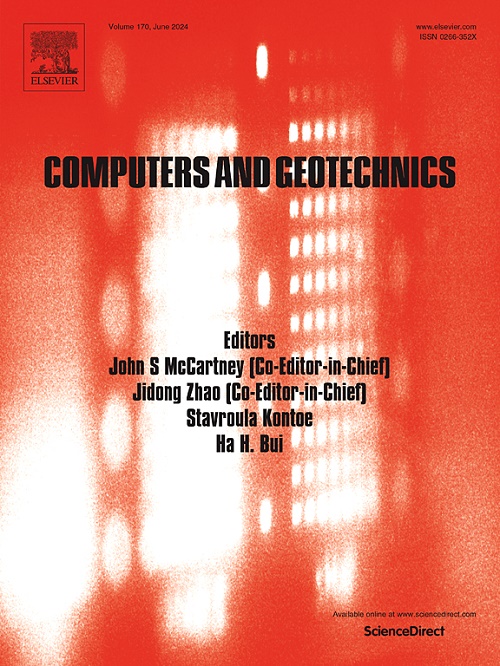Atomistic-scale sliding friction of fault gouge: Insight from a quartz-kaolinite-quartz system
IF 6.2
1区 工程技术
Q1 COMPUTER SCIENCE, INTERDISCIPLINARY APPLICATIONS
引用次数: 0
Abstract
Fault gouges are ubiquitous, which significantly reduces fault strength and affects earthquake rupture. However, the microscopic frictional behavior of the fault system, when considering the host rock and fault gouge as a coupled dual-interface structure, remains insufficiently understood. This study investigates the atomistic-scale frictional behavior of a quartz-kaolinite-quartz system using molecular dynamics. The interfacial forces during sliding are analyzed, and the effects of normal stress, sliding velocity and quartz crystallographic orientation on nanoscale friction are discussed. Results show that the friction force is positively correlated with the normal stress in the multi-friction surface system, consistent with previous findings of single-interface systems. Normal stress directly affects the slip behavior and the structural integrity of the kaolinite layer. As long as the normal stress does not reach the compressive strength limit of kaolinite, the kaolinite’s morphology always maintains the structural integrity. At lower normal stress, the Si-O plane of kaolinite serves as the primary slip surface. With increasing normal stress, the dominant slip surface gradually shifts to the Al-OH plane until the structural failure of kaolinite occurs. The friction of the quartz-kaolinite-quartz system increases with sliding velocity, showing a logarithmic velocity dependence due to thermal activation effects. Throughout the simulated velocities, the system consistently exhibits velocity-strengthening behavior. The crystallographic orientation of the quartz substrate significantly affects the friction force. This is attributed to differences in the distribution and amplitude of the potential energy ripples on the quartz surface, as well as variations in the dominant slip surfaces with different orientations. These findings could offer insights into the nanoscale mechanisms governing slip of fault gouges.
断层泥的原子尺度滑动摩擦:来自石英-高岭石-石英系统的洞察
断层带普遍存在,大大降低了断层强度,影响地震破裂。然而,断层系统的微观摩擦行为,当考虑到寄主岩石和断层泥作为一个耦合的双界面结构时,仍然没有得到充分的了解。本研究利用分子动力学研究了石英-高岭石-石英体系的原子尺度摩擦行为。分析了滑动过程中的界面作用力,讨论了正应力、滑动速度和石英晶体取向对纳米尺度摩擦的影响。结果表明,在多摩擦面体系中,摩擦力与法向应力呈正相关,与以往单界面体系的研究结果一致。法向应力直接影响高岭石层的滑移行为和结构完整性。只要法向应力未达到高岭石抗压强度极限,高岭石的形貌始终保持结构的完整性。在较低的法向应力下,高岭石的Si-O面为主要滑移面。随着法向应力的增大,主导滑移面逐渐向Al-OH面转移,直至高岭石发生结构破坏。石英-高岭石-石英体系的摩擦力随着滑动速度的增加而增加,由于热活化效应,呈现出对数速度依赖关系。在整个模拟速度过程中,系统始终表现出速度强化行为。石英衬底的晶体取向对摩擦力有显著影响。这主要是由于石英表面势能波纹的分布和振幅的不同,以及不同取向的优势滑移面也不同。这些发现可以深入了解控制断层滑动的纳米级机制。
本文章由计算机程序翻译,如有差异,请以英文原文为准。
求助全文
约1分钟内获得全文
求助全文
来源期刊

Computers and Geotechnics
地学-地球科学综合
CiteScore
9.10
自引率
15.10%
发文量
438
审稿时长
45 days
期刊介绍:
The use of computers is firmly established in geotechnical engineering and continues to grow rapidly in both engineering practice and academe. The development of advanced numerical techniques and constitutive modeling, in conjunction with rapid developments in computer hardware, enables problems to be tackled that were unthinkable even a few years ago. Computers and Geotechnics provides an up-to-date reference for engineers and researchers engaged in computer aided analysis and research in geotechnical engineering. The journal is intended for an expeditious dissemination of advanced computer applications across a broad range of geotechnical topics. Contributions on advances in numerical algorithms, computer implementation of new constitutive models and probabilistic methods are especially encouraged.
 求助内容:
求助内容: 应助结果提醒方式:
应助结果提醒方式:


